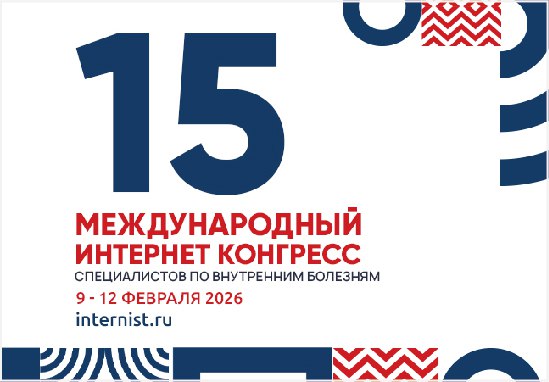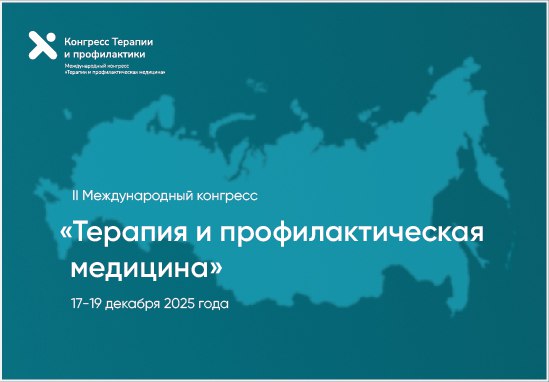Patients with prediabetes in the outpatient cardiology practice: challenges in the diagnosis and management of initial carbohydrate metabolism disorders
https://doi.org/10.20996/1819-6446-2025-3208
EDN: OCIAFJ
Abstract
Aim. To investigate the characteristics of diagnosis and pharmacotherapy of initial carbohydrate metabolism disorders (prediabetes) in cardiology patients within the framework of an outpatient registry
Material and methods. An observational cross-sectional study was conducted as part of the outpatient registry on inappropriate prescribing practices known as CHIP (Chuvashia Inappropriate Prescribing Study). The study focused on patients over 50 years old who sought consultation from a cardiologist at the cardiology dispensary. Data from the cardiologist’s outpatient records and patients’ medical documentation were analyzed based on the registry database. The term “impaired glucose tolerance (IGT)” in the registry records was used as an equivalent to “prediabetes”. Adherence to pharmacotherapy was assessed using the adherence scale developed by the National Society of Evidence-Based Pharmacotherapy.
Results. The CHIP registry included 300 patients: 120 (40%) men and 180 (60%) women. The mean age of the participants was 66.4±7.6 years. Baseline data on the absence/presence of carbohydrate metabolism disorders in the 300 registry patients were as follows: 202 patients had no carbohydrate metabolism disorders; 30 patients were diagnosed with impaired glucose tolerance (IGT): 67 had type 2 diabetes mellitus (T2DM), and 1 had type 1 diabetes (this patient’s data were excluded from further analysis). The most common test for assessing carbohydrate metabolism was the fasting blood glucose measurement, performed in 98% of the patients; HbA1c levels were determined in 22.4% of the participants, and only 12 patients (4%) underwent an oral glucose tolerance test (OGTT). Analysis of these test results indicated that 17 patients initially classified in the “no carbohydrate disorders” subgroup had fasting blood glucose levels meeting the criteria for prediabetes, while an additional 12 individuals from this subgroup and 13 patients with an original diagnosis of IGT met the criteria for T2DM. According to final data, 173 (57.9%) individuals in the studied cohort had no carbohydrate metabolism disorders, 34 (11.4%) had prediabetes, and 92 (30.7%) had T2DM. Waist circumference and body mass index (BMI) significantly increased in the T2DM group. An increase in the frequency of comorbidities, including arterial hypertension, chronic heart failure, atrial fibrillation, and ischemic heart disease (p=0.003), as well as a history of myocardial infarction, has been observed in patients with prediabetes and diabetes mellitus compared to those without carbohydrate metabolism disorders. The highest number of patients non-adherent to pharmacotherapy was observed in the subgroup without carbohydrate disorders, while the lowest was found among patients with T2DM. Metformin was prescribed to one in five patients diagnosed with prediabetes.
Conclusion. This study highlights the incomplete diagnosis of carbohydrate metabolism disorders, specifically prediabetes and type 2 diabetes mellitus, among cardiology patients. Furthermore, it illustrates the infrequent prescription of metformin for diabetes prevention, underscoring the critical need for heightened diagnostic vigilance regarding early carbohydrate disturbances in outpatient settings, not only by endocrinologists but also by physicians from other specialties.
About the Authors
Yu. V. LukinaRussian Federation
Yulia V. Lukina
Moscow
V. V. Tsaregorodtsev
Russian Federation
Victoria V. Tsaregorodtsev
Cheboksary
N. P. Kutishenko
Russian Federation
Natalia P. Kutishenko
Moscow
S. Yu. Martsevich
Russian Federation
Sergey Yu. Martsevich
Moscow
O. M. Drapkina
Russian Federation
Oksana M. Drapkina
Moscow
References
1. Cosentino F, Grant PJ, Aboyans V, et al.; ESC Scientific Document Group. 2019 ESC Guidelines on diabetes, pre-diabetes, and cardiovascular diseases developed in collaboration with the EASD. Eur Heart J. 2020;41(2):255-323. DOI:10.1093/eurheartj/ehz486. Erratum in: Eur Heart J. 2020;41(45):4317. DOI:10.1093/eurheartj/ehz828.
2. Drapkina OM, Mokrysheva NG, Shestakova MV, et al. Outpatient follow-up of patients with prediabetes by a general practitioner in primary health care. Methodological recommendations (edition 2). Moscow: ROPNIZ, 2024. 36 р. (In Russ.) [ DOI:10.15829/ROPNIZ-d100-2024.
3. Rooney MR, Fang M, Ogurtsova K, et al. Global Prevalence of Prediabetes. Diabetes Care. 2023;46(7):1388-94. DOI:10.2337/dc22-2376.
4. Echouffo-Tcheugui JB, Selvin E. Prediabetes and What It Means: The Epidemiological Evidence. Annu Rev Public Health. 2021;42:59-77. DOI:10.1146/annurev-publhealth-090419-102644.
5. ElSayed NA, Aleppo G, Aroda VR, et al., on behalf of the American Diabetes Association. 7. Diabetes Technology: Standards of Care in Diabetes-2023. Diabetes Care. 2023;46(Suppl 1):S111-27 / DOI:10.2337/dc23-S007.
6. International Expert Committee. International Expert Committee report on the role of the A1C assay in the diagnosis of diabetes. Diabetes Care. 2009;32(7):1327-34. DOI:10.2337/dc09-9033.
7. Dedov II, Shestakova MV, Mayorov AYu, et al. Standards of specialized diabetes care. Edited by Dedov I.I., Shestakova M.V., Mayorov A.Yu. 10th edition. Diabetes mellitus. 2021;24(1S):1-148. (In Russ.) DOI:10.14341/DM12802.
8. Knowler WC, Barrett-Connor E, Fowler SE, et al.; Diabetes Prevention Program Research Group. Reduction in the incidence of type 2 diabetes with lifestyle intervention or metformin. N Engl J Med. 2002;346(6):393-403. DOI:10.1056/NEJMoa012512.
9. Diabetes Prevention Program Outcomes Study Research Group; Orchard TJ, Temprosa M, Barrett-Connor E, et al. Long-term effects of the Diabetes Prevention Program interventions on cardiovascular risk factors: a report from the DPP Outcomes Study. Diabet Med. 2013;30(1):46-55. DOI:10.1111/j.1464-5491.2012.03750.x.
10. Mainous AG 3rd, Tanner RJ, Baker R. Prediabetes Diagnosis and Treatment in Primary Care. J Am Board Fam Med. 2016;29(2):283-5. DOI:10.3122/jabfm.2016.02.150252.
11. Martsevich SY, Tsaregorodtseva VV, Kutishenko NP, et al. Assessment of selftreatment in terms of inappropriate prescribing registry. Rational Pharmacotherapy in Cardiology. 2025;21(1):54-60. (In Russ.) DOI:10.20996/1819-6446-2025-3160.
12. Lukina YV, Kutishenko NP, Martsevich SY, et al. The Questionnaire Survey Method in Medicine on the Example of Treatment Adherence Scales. Rational Pharmacotherapy in Cardiology 2020;17(4):576-83. (In Russ.) DOI:10.20996/1819-6446-2021-08-02.
13. Richter B, Hemmingsen B, Metzendorf MI, Takwoingi Y. Development of type 2 diabetes mellitus in people with intermediate hyperglycaemia. Cochrane Database Syst Rev. 2018;10(10):CD012661. DOI:10.1002/14651858.CD012661.pub2.
14. Diabetes Prevention Program Research Group. Long-term effects of lifestyle intervention or metformin on diabetes development and microvascular complications over 15-year follow-up: the Diabetes Prevention Program Outcomes Study. Lancet Diabetes Endocrinol. 2015;3(11):866-75. DOI:10.1016/S2213-8587(15)00291-0.
15. Garonzi C, Maguolo A, Maffeis C. Pros and Cons of Current Diagnostic Tools for Risk-Based Screening of Prediabetes and Type 2 Diabetes in Children and Adolescents with Overweight or Obesity. Horm Res Paediatr. 2023;96(4):356-5. DOI:10.1159/000528342.
16. Bergman M, Abdul-Ghani M, DeFronzo RA, et al. Review of methods for detecting glycemic disorders. Diabetes Res Clin Pract. 2020;165:108233. DOI: 10.1016/j.diabres.2020.108233. Erratum in: Diabetes Res Clin Pract. 2021;180:108632. DOI:10.1016/j.diabres.2020.108632.
17. Meijnikman AS, De Block CEM, Dirinck E, et al. Not performing an OGTT results in significant underdiagnosis of (pre)diabetes in a high risk adult Caucasian population. Int J Obes (Lond). 2017;41(11):1615-20. DOI:10.1038/ijo.2017.165.
18. Kalaidzhyan EP, Kutishenko NP, Lukina YV, et al. Outpatient follow-up of patients with myocardial infarction and early carbohydrate metabolism disorders. Cardiovascular Therapy and Prevention. 2025;24(3):4222. (In Russ.) DOI:10.15829/1728-8800-2025-4222.
19. Lukina YV, Martsevich SY, Kutishenko NP, et al. Prediabetes: problems of diagnostics and treatment of initial carbohydrate metabolism disorders in real-world practice (data from the PROFILE outpatient registry). Cardiovascular Therapy and Prevention. 2025;24(4):4188. (In Russ.) DOI:10.15829/1728-8800-2025-4188.
20. Lukina YV, Zagrebelny AV, Kutishenko NP, et al. Bene dignoscitur, bene curatur: Analysis of implementation of diagnostic and therapeutic measures for pre-diabetes management in clinical practice conditions (according to the data of the REGION-M hospital and outpatient register). Therapy. 2024; 10(9):7-14. (In Russ.) DOI:10.18565/therapy.2024.9.7-14.
Supplementary files
Review
For citations:
Lukina Yu.V., Tsaregorodtsev V.V., Kutishenko N.P., Martsevich S.Yu., Drapkina O.M. Patients with prediabetes in the outpatient cardiology practice: challenges in the diagnosis and management of initial carbohydrate metabolism disorders. Rational Pharmacotherapy in Cardiology. 2025;21(4):380-386. (In Russ.) https://doi.org/10.20996/1819-6446-2025-3208. EDN: OCIAFJ
















































